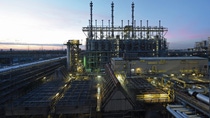Sustainability
BASF expands portfolio of climate friendly products introducing the first isocyanate not carrying a CO2 backpack
February 7, 2022
BASF expands the portfolio of methylene diphenyl diisocyanate (MDI) and introduces with Lupranat® ZERO (Zero Emission, Renewable Origin) the first greenhouse gas neutral aromatic isocyanate. Lupranat ZERO has an accounting Cradle-to-Gate1 Product Carbon Footprint2 (PCF) of zero; this means that on its way until it leaves the BASF factory gate for the customer - all product-related greenhouse gas emissions and the biobased carbon bound in the product taken together - it does not carry a CO2 backpack.

Zero emissions up to the factory gate are achieved without offset certificates. Instead, renewable raw materials are used at the beginning of the chemical production chain and allocated via a mass balance process. In addition, renewable energies are used for the manufacturing process with green energy cetificates (e.g. Renewable Energy Certificates).
The verification of the PCF calculation of Lupranat ZERO by TÜV Nord has been successfully completed. “We have checked the calculation of the PCF of Lupranat ZERO M 70 R in detail and are now pleased to be able to confirm it for the first time," says Delia Carls, auditor at TÜV NORD. Lupranat ZERO will be available in the second quarter of 2022.
"Climate protection is becoming increasingly important for our customers. With reliable data on the CO2 footprint of our products, we can support our customers in achieving their climate targets. By using Lupranat ZERO, our customers can quantifiably reduce their CO2 footprint while maintaining the same high product quality and thus make an active contribution to climate protection," says Dr. Ramkumar Dhruva, President Monomers BASF.
Lupranat ZERO will be available in the first for Lupranat M 70 R. The application is for the production of MDI polyisocyanurate panels (also known as PIR or polyiso) and rigid polyurethane foam in the construction industry. The rigid foam boards are extremely durable and are used for thermal insulation. BASF is initially introducing ZERO for Lupranat M 70 R, with other Lupranat product variants to follow.
BASF has set itself the ambitious goal of reducing greenhouse gas emissions by 25 percent by 2030 compared to 2018 emissions. The individual PCFs of BASF products play an important role on this path, creating the necessary transparency about the associated greenhouse gas emissions.
Based on actual energy and raw material consumption from 2021, the PCF was also determined for MDI and is now available to customers. In addition, products are already part of BASF's portfolio for MDI that have been manufactured using renewable raw materials (Lupranat® BMB) or recycled raw materials (Lupranat® cCycled) and thus make a positive contribution to sustainability in the polyurethane value chain.
1 Cradle-to-Gate-consideration according to ISO14067 including biogene assimilation. The cradle-to-gate PCF considers all processes from resource extraction, through pre-product manufacture and end-product manufacture, to the point at which the product leaves the company.
2 BASF's PCFs are calculated according to ISO 14067:2018, the ISO standard for carbon footprint. This is based on the general principles and requirements of the ISO standards ISO 14040:2006 and ISO 14044:2006 for life cycle assessments.
